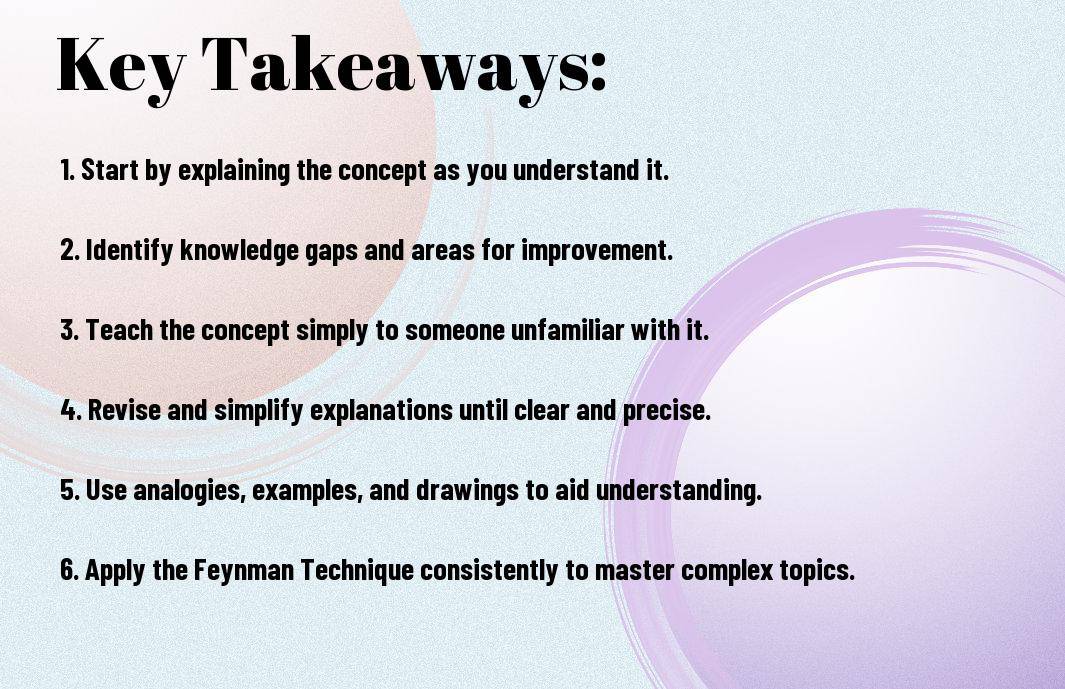
Newsletter Subscribe
Enter your email address below and subscribe to our newsletter

Enter your email address below and subscribe to our newsletter

The Feynman Technique! Most individuals struggle when faced with intricate concepts or difficult subjects. Richard Feynman, a renowned physicist, developed a method that simplifies the process of understanding complex ideas. Known as “The Feynman Technique,” this approach breaks down difficult topics into digestible components, making them easier to comprehend.


While Richard Feynman was a Nobel Prize-winning physicist known for his exceptional ability to teach and simplify complex concepts, his approach was surprisingly straightforward. The essence of the Feynman Technique lies in breaking down complex ideas into simple terms that anyone can understand.
An crucial aspect of the Feynman Technique involves the process of explaining a concept as if you were teaching it to someone else. This method forces you to clarify your understanding and fill in any gaps in your knowledge. By simplifying the concept into basic terms, you can identify where you might be struggling and need to revisit the material.
For individuals looking to truly master a subject, the Feynman Technique offers immense benefits. By actively engaging with the material and teaching it in simple terms, you not only solidify your own knowledge but also gain a deeper understanding of the topic. This technique helps to uncover any areas of confusion and prompts further exploration to enhance comprehension.
For those seeking to retain information long term, the Feynman Technique is a powerful tool. By breaking down complex ideas into layman’s terms and teaching them to others, you strengthen your memory and retention capabilities. This method not only aids in understanding the material but also facilitates recall and application in real-world scenarios.

Once again, let’s explore into the four fundamental steps of The Feynman Technique, a strategy devised by physicist Richard Feynman to simplify complex ideas and enhance understanding. By following these steps, individuals can grasp intricate concepts and effectively communicate them to others.
Step 1: To begin with The Feynman Technique, select a concept or topic you want to understand better. It could be a theory, principle, or any subject matter that seems challenging or confusing to you. By identifying a specific idea, you can focus your efforts on dissecting and comprehending it thoroughly.
OnStep 2: Once you have chosen the concept, imagine yourself teaching it to a child who has no prior knowledge of the subject. The key is to simplify the explanation to its most basic form, using everyday language and avoiding technical jargon. This exercise can help you identify gaps in your understanding and clarify any unclear points.
Technique: Teaching a complex idea to a child forces you to break it down into simple, digestible parts. By doing so, you not only reinforce your own comprehension but also improve your ability to convey the information to others in a clear and concise manner.
ChooseStep 3: In this step, review your explanation of the concept and simplify it further if needed. Identify any areas where you might be overcomplicating the information or using unnecessary details. The goal is to refine your understanding to its core elements, making it easier to grasp and articulate.
Simplify: By simplifying your explanation, you can distill the concept down to its imperative components, making it more accessible and comprehensible. This step is crucial in ensuring that you have a clear understanding of the concept before moving on to the final step of organizing and conveying it effectively.
ForStep 4: The last step of The Feynman Technique involves organizing your simplified explanation in a coherent manner and conveying it to someone else. This could be through writing a summary, creating a presentation, or engaging in a discussion with a peer. By articulating the concept in a structured way, you solidify your understanding and enhance your ability to communicate it effectively.
Step: Organizing your thoughts and conveying them to others not only reinforces your own learning but also allows you to test the depth of your understanding. By presenting the concept in a logical and concise manner, you can gauge how well you have internalized the information and identify any areas that may still need clarification.
All fields of academic learning can benefit from the application of the Feynman Technique. By simplifying complex ideas into easy-to-understand concepts, students can enhance their understanding of difficult subjects. To apply this technique, one must first select a topic and explain it as if teaching it to a novice. Identifying gaps in knowledge during this process can guide further study, eventually leading to a more profound comprehension of the subject.
All professionals can leverage the Feynman Technique to enhance their skills and knowledge in various fields. By breaking down intricate concepts into simplified explanations, individuals can develop a deeper understanding of their work. This approach can be particularly useful in industries like technology, finance, and healthcare, where complex ideas are commonplace.
Development through the Feynman Technique involves constant refinement and reinforcement of knowledge. By engaging in a cyclical process of learning, explaining, and refining, professionals can solidify their expertise and excel in their careers. This method not only fosters a deeper understanding but also improves communication skills and critical thinking abilities.
To enhance your learning experience while using the Feynman Technique, consider adopting effective note-taking methods. One useful approach is the Cornell method, where you divide your paper into sections for main points, supporting details, and summarizations. This structured format helps you organize information and facilitates the retrieval process later on. Another popular method is mind mapping, which involves creating visual diagrams to connect ideas and concepts. Find the method that works best for you to capture key details and aid in comprehension.
To reinforce your understanding of complex ideas, incorporate visualization techniques into your learning process. When explaining a concept using the Feynman Technique, try to create mental images or diagrams that represent the information. Visual aids can significantly enhance your memory retention and help you grasp abstract concepts more easily. You can also use online tools like mind-mapping software or diagramming applications to create interactive visuals that bring clarity to intricate subjects.
Methods: Visualizing information can make it more tangible and relatable, aiding in your understanding of complex ideas. By incorporating visual elements into your study routine, you can streamline the learning process and retain information more effectively.

For individuals learning the Feynman Technique, it is crucial to understand the distinction between simplifying complex ideas and oversimplifying them. Simplifying involves breaking down intricate concepts into more manageable parts without losing the core essence of the information. On the other hand, oversimplifying entails stripping down the material to such a basic level that important nuances and details are lost, leading to a superficial understanding.
Overcoming confusion and addressing knowledge gaps are common challenges when applying the Feynman Technique. It is necessary to acknowledge any areas of uncertainty or lacking information during the learning process and actively seek to fill these gaps through additional research or asking questions. By addressing these knowledge gaps, individuals can ensure a more comprehensive understanding of the subject matter.
Simplifying complex ideas using the Feynman Technique requires a balance between simplification and retaining necessary details. By recognizing and addressing confusion and knowledge gaps, learners can enhance their grasp of intricate concepts and improve their overall retention and mastery of the material.
After mastering the basics of a concept using the Feynman Technique, it’s time to advance to the next level. This stage involves delving deeper into the subject matter and exploring more complex ideas to broaden your understanding. By building upon the foundation you’ve already established, you can embrace the intricacies of the topic and develop a more comprehensive grasp of it.
Iterative learning with the Feynman Technique involves revisiting your understanding of a concept and refining it through repetition and practice. By continuously applying the technique to different aspects of the subject, you can uncover new insights and reinforce your knowledge. This iterative process allows you to identify any gaps in your understanding and address them effectively, leading to a more robust comprehension of the topic.
Introducing complexity and depth gradually is a key strategy in advancing your knowledge with the Feynman Technique. Instead of overwhelming yourself with intricate details from the start, it’s crucial to incrementally introduce more challenging concepts as you become comfortable with the basics. This gradual progression enables you to build upon your existing knowledge in a structured manner, making the learning process more manageable and rewarding.
On the journey to mastering complex ideas, it’s crucial to strike a balance between exploring new depths and consolidating your understanding of the fundamentals. By incrementally increasing the complexity of the concepts you tackle, you can push your boundaries while ensuring a solid grasp of the material. This approach not only enhances your knowledge but also hones your critical thinking skills, enabling you to tackle even more challenging subjects with confidence.
Now that you’ve learned about the Feynman Technique, you have a powerful tool for mastering complex ideas. By simplifying and teaching concepts to others, you can deepen your own understanding and identify gaps in your knowledge. This approach, championed by physicist Richard Feynman, can help you tackle any subject matter with confidence and clarity. To probe further into how to master concepts using the Feynman Technique, check out 🧠 Mastering Concepts with the Feynman Technique!
A: The Feynman Technique is a method developed by physicist Richard Feynman to simplify and understand complex ideas. It involves breaking down concepts into simple terms to ensure a deep understanding of the subject.
A: The Feynman Technique works by explaining a concept as if you were teaching it to a child. This process helps identify gaps in your understanding and solidifies your knowledge through the act of simplifying and teaching.
A: The Feynman Technique is effective because it forces you to confront your understanding of a topic and exposes any areas of confusion. By simplifying the concept and teaching it to others, you reinforce your understanding and retention of the material.
A: The Feynman Technique is beneficial when you encounter complex or challenging ideas that you need to grasp fully. It is especially helpful for students, educators, and anyone looking to enhance their understanding of a subject.
A: The steps of the Feynman Technique are as follows:
1. Choose a concept you want to understand.
2. Explain the idea in simple terms, as if teaching it to a child.
3. Identify any gaps or areas of confusion in your explanation.
4. Review the complex areas and simplify them further if needed.
A: Yes, the Feynman Technique can be applied to a wide range of subjects and topics. Whether you are studying science, history, mathematics, or any other subject, the technique can help you break down and master complex ideas.
A: To implement the Feynman Technique effectively, choose a quiet study space, break down the concept into manageable parts, and focus on explaining each part clearly and concisely. Practice teaching the concept to others or writing out your explanation for reinforcement.
Pomodoro Technique – Francesco Cirillo’s Method to Improve Focus and Manage Time